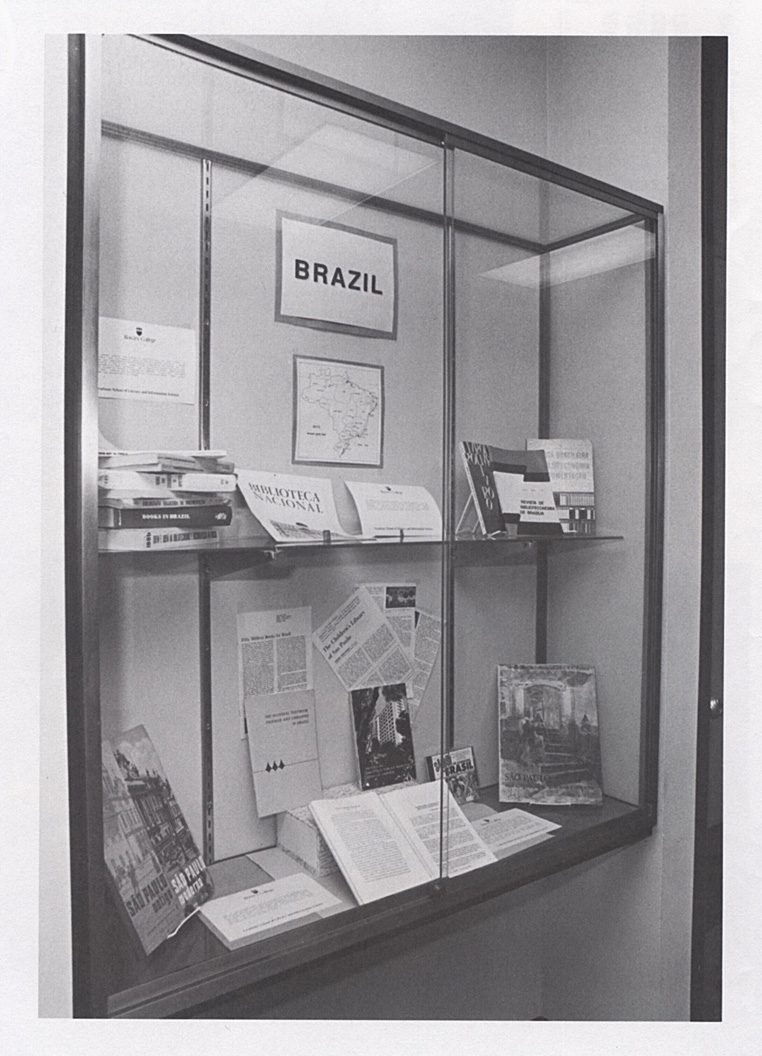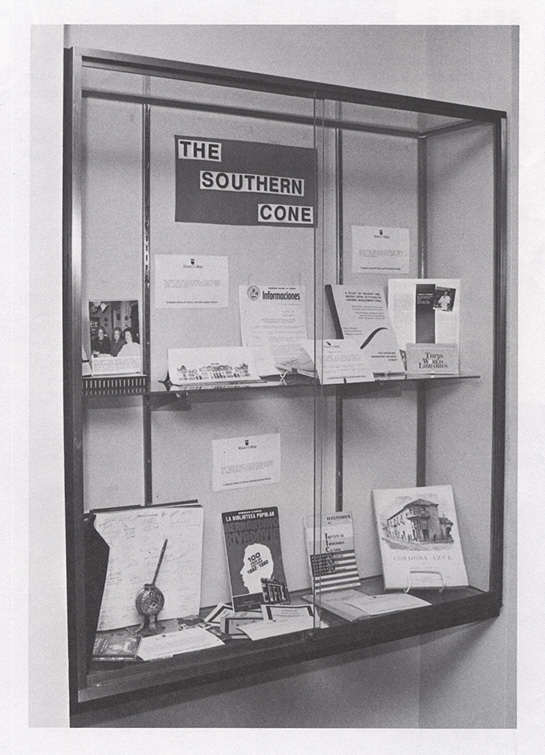
This exhibition, prepared as one of the 1992 international activities of the Graduate School of Library and Information Science, Rosary College, attempts to show the varied and diverse nature of library development in Latin America 500 years after the first voyage of Columbus to the “New World.̵ It deals not only with libraries and their collections but also with the figures in the field, whether librarians, bibliographers, historians, or professors. The exhibition was on view on the third floor of Rosary’s Rebecca Crown Library from the summer of 1992 through early 1993. It was planned and mounted by William V. Jackson. The text which accompanies the photographs on these pages is drawn primarily from labels accompanying the items on display.
This case is intended as an introduction; it shows some general works and presents information about three persons (Dorothy Collings, Carlos Victor Penna, and Marietta Daniels Shephard) as examples of individuals who have played a significant role in Latin American librarianship in the past two or three decades.
Another section of this case deals with the literature of the field, which is widely scattered in monographic works and serials. Much of the most useful data, however, comes from “grey literature”—conference papers, proposals for library development, annual reports, pamphlets, and even newspaper accounts—which few American (and Latin American) libraries collect in depth. To this must now be added such audio–visual items as oral and video tapes, slides, photographs, architectural plans, and computer tapes. Two of the best library and information science collections in Latin America are found in the Instituto Bibliotecológico at the University of Buenos Aires and the Inter–American Library School (EIBM) at the University of Antioquila in Medellín.
Each of the five remaining cases in the exhibition covers one geographic area: Central America and Mexico, the Caribbean, Andean Countries, Brazil, and the Southern Cone.

In recent years the Directorate of Public Libraries in Mexico has promoted rapid expansion of public libraries, and it has also commissioned a series of books, each devoted to the history of libraries in an individual state.
One of Mexico’s distinguished librarians was Juana Manrique de Lara (1899–1983). In addition to her work as Inspector General of Libraries, she found time to teach and to write. One of the works shown here is on school libraries, and the other is a general treatise.
The first U.S. information library abroad was the Benjamin Franklin Library, established in Mexico City in 1942. It has been widely hailed by Mexicans as the most important U.S. cultural program in their country.
The remainder of this case covers representative library activities from the Central American countries. Most Latin American countries have established national scientific and technological councils; one of their functions related to obtaining and disseminating scientific and technical information. Typical are the annual reports from Costa Rica’s council (CONICIT). Despite the internal struggles in Nicaragua, the medical school in Léon has a new building which provides very adequate quarters for the library. The Inter–American Development Bank (:BID) provided financial aid for the construction. The Francisco Marroquín University in Guatemala has a new library building. To celebrate its completion a two–day library symposium took place in January 1992. In Honduras the national university library (UNAH) has made enormous strides in recent years. Now well organized and staffed, it is beginning to automate bibliographic records.
More than 100 binational centers exist in Latin America. They are independent local institutions, established to promote good relations between the countries where they are located and the U.S. Each maintains a library about all aspects of the U.S. life and culture. For three consecutive years (1989–1991) the binational center in Tegucigalpa, Honduras, sponsored an intensive workshop on library organization; in 1991 the National Library sent more than 20 of its staff as participants.

Library development in the Caribbean is as varied as the socio–economic picture of English, Spanish, French, and Dutch speaking islands. Cuba provided a new building for the Jose Martí National Library before the 1959 revolution; celebrating its 90th anniversary in 1991, the Library continues to publish its journal. Although there is no library school in the Dominican Republic, the Instituto Tecnológico (INTEC) has considered opening one. Several private universities were founded in the past few decades. One of them (UNPHU) bears the name of the distinguished literary figure, Pedro Henríquez Ureña. The Catholic University (Universidad Católica Madre y Maestra) has its main campus in Santiago and operates a branch in Santo Domingo.
One of the leading figures in Caribbean university librarianship is Alma Jordan, who has written extensively on library cooperation in this area and is past–president of both ACURIL and SALALM.
Even before independence in 1962, library development in Jamaica had reached a “take–off” point with the founding of the Jamaica Library Service in 1948. Now covering the entire island from headquarters in Kingston, JLS also administers, on behalf of the government, the provision of library service in the primary and secondary schools. The University of the West Indies has its main library in Mona (a suburb of Kingston); the College of Arts, Science and Technology (CAST) is nearby, as are a number of special libraries and information centers, and the national library. The coordinating mechanism is NACOLAIS, the National Commission on Libraries, Archives and Information Services.

Here are presented library and information activities in the Andean countries.
The University of San Marcos in Lima illustrates the havoc that socio–economic conditions sometimes wreak upon libraries. The University libraries had, over the years, built up collections and provided good bibliographical access but the present conditions in Peru have resulted in an institution in peril.
Colombia’s capital, Bogotá, and Medellín are the country’s two most important “library cities.” In Bogotá are a number of university libraries, the National Library, and the Biblioteca Luis Angel Arango, as well as special libraries. Medellín also has university libraries plus the UNESCO pilot public library for Latin America and the Inter–American Library School.
In 1970 an OAS team went to Colombia for several months to plan the development of library and information services. The team surveyed the library situation at that time and made a number of recommendations for steps that could be taken immediately for some improvement.
The Inter–American Library School (EIBM) at the University of Antioquia in Medellín was founded in 1956. For some years the EIBM occupied pleasant and spacious quarters in an old mansion, El Castillo de los Botero.
The Chilean Alberto Villalón was the first Latin American to receive a Ph.D. in library science. Trained also as a lawyer, he has compiled a monumental Bibliografía jurídica (Legal bibliography). Here he is seen at the library of the Metropolitan University (Universidad Metropolitana) in Caracas.
Another important figure in Venezuela is Pedro Grases, historian and bibliographer. He has written extensively on Andrés Bello and other historical topics. An avid book collector, Grases gave his personal library to the Metropolitan University, where it is now housed in special quarters.

This case is devoted to Brazil.
The Brazilian government decided to leave the National Library (Biblioteca Nacional) in Rio de Janeiro when Brasília became the capital. One of the largest in Latin America, the library occupies an impressive building in downtown Rio.
One of the largest book and library projects ever undertaken in Brazil was the National Textbook program, a joint USAID/Brazilian government venture. Its goal was to produce 51 million textbooks for primary, secondary, and higher education. Although not primarily a library program, the ramifications through the library world were many, as indicated in one advisor’s report.
The São Paulo Public Library (Biblioteca Municipal) is a landmark in the city, although there are now many higher skyscrapers. There is a non–circulating research collection in the main building; many branch libraries throughout the city offer borrowing privileges. One of the early directors was Rubens Borba de Moraes, a distinguished Brazilian bibliographer. Revista de bibliotecnomia de Brasília published a festschrift issue for his 80th birthday in 1979.
It should be noted that São Paulo’s library does not offer service to children, because there is an entirely separate system (main library and branches) for them: the Children’s Library (Biblioteca Infantil).

This case presents library and information services in the four countries of the Southern Cone.
The University of Buenos Aires was long considered one of the finest in Latin America, and its libraries still have the largest collections in Argentina.
At the end of the 19th century, under the leadership of President Domingo Faustino Sarmiento, the Argentines founded many popular (i.e., subscription) libraries. One of the largest, the Bernardino Rivadavia Library in Bahía Blanca, celebrated its centenary 10 years ago.
Three distinguished Argentine librarians are Josefa Emilia Sabor, author of Manuel de fuentes de información, the first guide to reference books in Spanish; Lydia Revello, specialist in agricultural libraries; and Susana Romanos de Tiratel, director of the library school, University of Buenos Aires.
The greatest Latin American bibliographer, José Toribio Medina (1852–1930), was a Chilean, and the National Library in Santiago maintains a reading room housing his private library of 40,000 volumes.
One of the first library fellows in the ALA/USIS program was Elizabeth Steinhagen. She spent six months at the binational center in Santiago in 1987/88.
The two other countries in the Southern cone provide some interesting contrasts. Library development came earlier in Uruguay, which (like some other Latin American countries) has a full–scale USIS operation, the Artigas–Washington Library. Paraguay has fewer libraries, smaller collections, and—until recently—a smaller number of trained librarians.
© 1992 Dominican University
Citation
Dominican University, “Librarianship in Latin America: An Exhibition” Third World Libraries, Volume 3, Number 1 (Fall 1992).